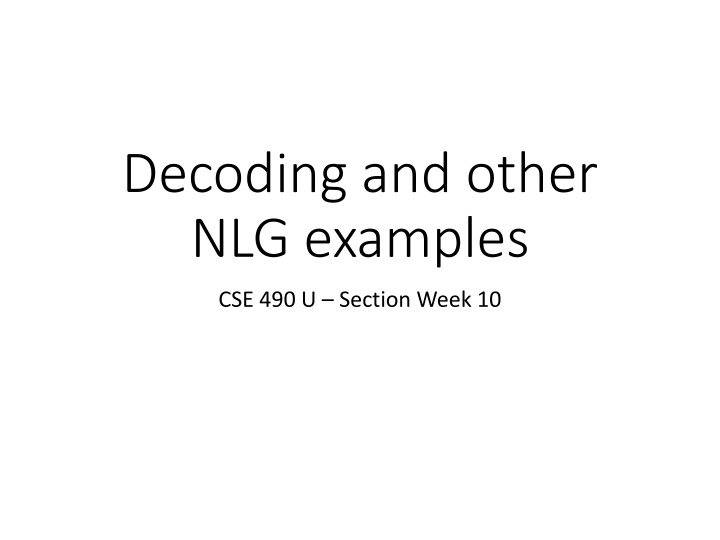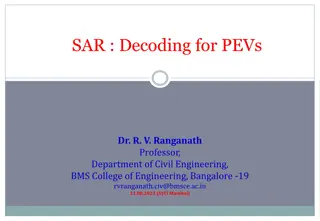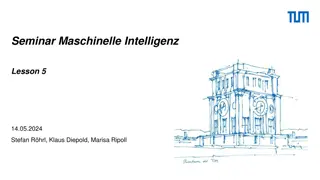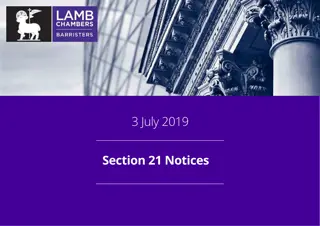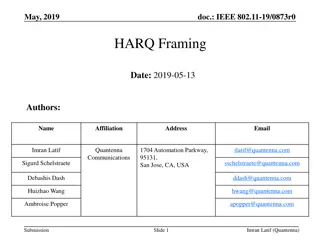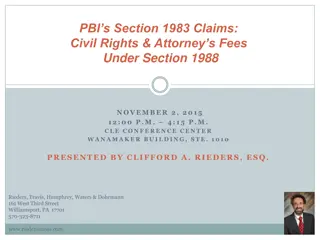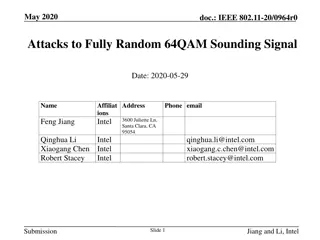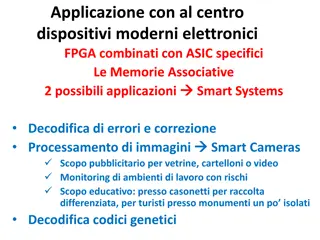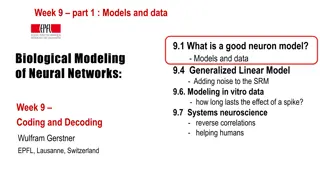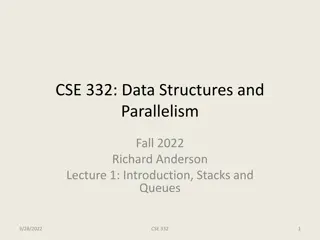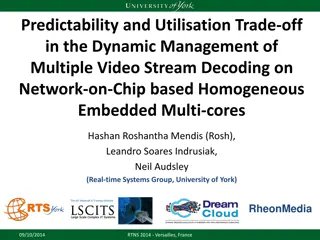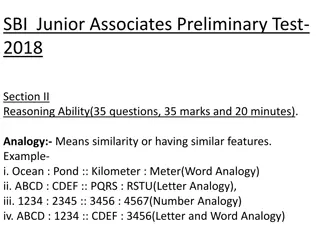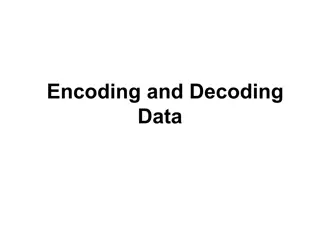Decoding and NLG Examples in CSE 490U Section Week 10
This content delves into the concept of decoding in natural language generation (NLG) using RNN Encoder-Decoder models. It discusses decoding approaches such as greedy decoding, sampling from probability distributions, and beam search in RNNs. It also explores applications of decoding and machine translation ideas in non-MT domains like stylistic paraphrasing and Twitter conversations. The process of encoding input and generating output in RNN Encoder-Decoder models is explained, with insights on training and testing phases. Additionally, it covers the generation of probability distributions for next-word predictions and the implementation of greedy decoding.
Download Presentation

Please find below an Image/Link to download the presentation.
The content on the website is provided AS IS for your information and personal use only. It may not be sold, licensed, or shared on other websites without obtaining consent from the author.If you encounter any issues during the download, it is possible that the publisher has removed the file from their server.
You are allowed to download the files provided on this website for personal or commercial use, subject to the condition that they are used lawfully. All files are the property of their respective owners.
The content on the website is provided AS IS for your information and personal use only. It may not be sold, licensed, or shared on other websites without obtaining consent from the author.
E N D
Presentation Transcript
Decoding and other NLG examples CSE 490 U Section Week 10
Outline Decoding from RNNs: Greedy decoding (in HW5) How to sample from a probability distribution Beam search on RNNs Applications of decoding/MT ideas in non-MT domains: Stylistic paraphrasing Twitter Conversation
Decoding Given an input X, encoding turns X into some representation. With RNN Encoder-Decoder: Encoded(X) = Hidden State at final step = Encoded( This is a sentence ) <BOM> This is a sentence <EOM>
Decoding Given an input X, encoding turns X into some representation. With RNN Encoder-Decoder: Encoded(X) = Hidden State at final step <BOM> This is a sentence <EOM> How to pick the output word? <EOM> This sentence <BOM> a is
Decoding during training Target output is known! Just feed that as input => each predicted output depends on previous states and input, not on previous outputs. <BOM> This is a sentence <EOM> <EOM> This sentence <BOM> a is
Decoding during testing Target output is unknown! 3 main approaches: Greedy (most probable word) Sample from the distribution Beam search <BOM> This is a sentence <EOM> <EOM> This sentence <BOM> a is
Reminder: output of RNN Embedded predicted output un-embed #1 Prob dist. over next word softmax #2 RNN Input <EOM> # Creating prob. dist. over next symbol out = tf.matmul(emb_out,un_emb) #1 sm = tf.nn.softmax(out) #2
Greedy decoding At every time-step, take the most probable word <BOM> This is sentence <EOM> a argmax <EOM> This sentence <BOM> a is
Greedy decoding HW 5 # Here, we're no longer training, so # at each decoding step, for each word # that we chose, we have to pick the most # probable word from the prob. # dist. given by the softmax. This is # why this code loops. state = init_state # The first symbol is always the <BOM> # (beginning of message) symbol inp = emb_target_list[0] with tf.variable_scope("unembedding"): # defining the un-embedding parameter. un_emb = tf.transpose(emb) output_list = [] softmax_list = [] with tf.variable_scope("RNN"): for i in range(max_seq_len): if i != 0: # needed to call cell multiple times tf.get_variable_scope().reuse_variables() # Take one pass through the cell emb_out, state = cell(inp,state) # Creating prob. dist. over next symbol out = tf.matmul(emb_out,un_emb) sm = tf.nn.softmax(out) # Taking most probable output and # embedding it again. inp = tf.nn.embedding_lookup( emb,tf.argmax(sm,1)) # Saving the output distribution output_list.append(out) softmax_list.append(sm)
Greedy decoding At every time-step, take the most probable word <BOM> This is sentence <EOM> a Can anyone think of a problem with this? argmax <EOM> This sentence <BOM> a is
Greedy decoding What if two words were p(word1) = .49, p(word2)=.51? What about the future? Usually, greedy decoding is acceptable (especially to save time), but not preferred. Alternative: Random sampling
Random sampling decoding For every word, randomly sample from the distribution As far as I know, have to do this offline i.e. not in the computation graph definition # Sampling from a prob. Distribution softmax import numpy as np next_word_id = np.random.choice( len(softmax), # choose from [0,|V|-1] p=softmax # according to these probabilities )
Random sampling what does that mean? .2 .2 .6 ? = that is, ? 1 = .2,? 2 = .2,? 3 = .6 Randomly sampling from this distribution is equivalent to randomly selecting an element from the set {1,1,2,2,3,3,3,3,3,3}. Asymptotically, we end up with: 20% class 1 20% class 2 60% class 3
Random sampling decoding <BOM> This was a word <EOM> Random sample! <EOM> This word <BOM> a was
Random sampling decoding Only considering one possible output Randomness usually picks some of the most probable words Why not consider multiple probably options? Does choice at time t impact future? Hint: remember HMMs & transition probabilities?
Beam search decoding Instead of using one output per time-step, use the top K most probable. Intuition: Ruling out the 2ndmost probable can have devastating consequences in the end. Decisions at earlier time-steps can impact probability of entire sequence. Similar intuition to Viterbi for HMMs.
Beam search High level algorithm Beam size K 1. Start with <BOM> symbol, feed into RNN 2. Take K most probable output symbols, store K triples: ?????? = (??????, (1), < ??? > ) where is hidden state 3. For t < max_seq_length: 1. For (??????, (1), < ??? > ) in inputs: 1. Run through RNN, take K most prob output symbols 2. Take ? most prob. From the list of ? ? output symbols 3. Update ?????? with the new ? best & start again
Beam search a walk through Beam size: 3 (2),world: .12, 1 (1),Hello 1 STOP: all three words are <EOM> (2),world: .11, 2 (1),Hi 2 (2),<EOM>: .09, 1 (1),Hello 3 (3),<EOM>: 1.0, 3 (2),<EOM> 1 (2),there: .10, 1 (1),Hello (1),Hello: .15, (0),<BOM> 4 1 (3),<EOM>: .5, 1 (2),world 2 (2),there: .10, 3 (1),Hey (1),Hi: .10, (0),<BOM> 5 2 (3),<EOM>: .5, 2 (2),world 3 ... (1),Hey: .10, (0),<BOM> 3 ... (0),<BOM>:1.0,-,- state, word: prob, prev_state, prev_word
Beam search a walk through Beam size: 3 Backtracking (2),world: .12, 1 (1),Hello 1 (2),world: .11, 2 (1),Hi 2 (2),<EOM>: .09, 1 (1),Hello 3 (3),<EOM>: 1.0, 3 (2),<EOM> 1 (2),there: .10, 4 (2),Hello (1),Hello: .15, (0),<BOM> 4 1 (3),<EOM>: .5, 1 (2),world 2 (2),there: .10, 4 (2),Hey (1),Hi: .10, (0),<BOM> 5 2 (3),<EOM>: .5, 2 (2),world 3 ... (1),Hey: .10, (0),<BOM> 3 ... (0),<BOM>:1.0,- ,- ?(<BOM> Hello <EOM> <EOM> ) = 1 .09 .15 = .0135 state, word: prob, prev_state, prev_word
Beam search a walk through Beam size: 3 Backtracking (2),world: .12, 1 (1),Hello 1 (2),world: .11, 2 (1),Hi 2 (2),<EOM>: .09, 1 (1),Hello 3 (3),<EOM>: 1.0, 3 (2),<EOM> 1 (2),there: .10, 4 (2),Hello (1),Hello: .15, (0),<BOM> 4 1 (3),<EOM>: .5, 1 (2),world 2 (2),there: .10, 4 (2),Hey (1),Hi: .10, (0),<BOM> 5 2 (3),<EOM>: .5, 2 (2),world 3 ... (1),Hey: .10, (0),<BOM> 3 ... (0),<BOM>:1.0,- ,- ?(<BOM> Hello world <EOM> ) = .5 .12 .15 = .009 state, word: prob, prev_state, prev_word
Beam search a walk through Beam size: 3 Backtracking (2),world: .12, 1 (1),Hello 1 (2),world: .11, 2 (1),Hi 2 (2),<EOM>: .09, 1 (1),Hello 3 (3),<EOM>: 1.0, 3 (2),<EOM> 1 (2),there: .10, 4 (2),Hello (1),Hello: .15, (0),<BOM> 4 1 (3),<EOM>: .5, 1 (2),world 2 (2),there: .10, 4 (2),Hey (1),Hi: .10, (0),<BOM> 5 2 (3),<EOM>: .5, 2 (2),world 3 ... (1),Hey: .10, (0),<BOM> 3 ... (0),<BOM>:1.0,- ,- ?(<BOM> Hi world <EOM> ) = .5 .12 .15 = .009 state, word: prob, prev_state, prev_word
Beam search Store O(K*max_seq_length) elements Fast if you can parallelize the computation Usually gives a boost in accuracy! Any questions on beam search or decoding?
Natural Language Generation Stylistic Paraphrasing Xu et al. COLING 2012 Paraphrasing for Style Conversation modelling Ritter et al. EMNLP 2011 Data-driven Response Generation in Social Media Li et al. NAACL 2016 A Diversity Promoting Objective Function for Neural Conversation Sordoni et al. NAACL 2015 A Neural Network Approach to Context- Sensitive Generation of Conversational Responses Serban et al. arXiv 2016 A Hierarchical Latent Variable Encoder- Decoder Model for Generating Dialogues
Stylistic Paraphrasing Source Speaker Input Output Romeo & Juliet Benvolio He killed your relative, brave Mercutio, and then young Romeo killed him. he slew thy kinsman , brave mercutio , and then young romeo kill him . Romeo & Juliet Romeo I can read my own fortune in my misery. i can read mine own fortune in my woes . Star Wars Palpatine If you will not be turned, you will be destroyed! if you will not be turn d , you will be undone ! Star Wars Luke Father, please! Help me! father , i pray you , help me ! The Matrix Agent Smith Good bye, Mr. Anderson. fare you well , good master anderson . The Matrix Morpheus I m trying to free your mind, Neo. But I can only show you the door. You re the one that has to walk through it. i ll to free your mind , neo. but i can but show you the door. you re the one that hath to tread it . Raiders of the Lost Ark Bellow Good afternoon, Dr. Jones. well met , dr. jones . Raiders of the Lost Ark Jones I ought to kill you right now. i should kill thee straight .
Conversation modelling Ritter et al. 2011
Conversation modelling Li et al. NAACL 2016
Conversation modelling Sordoni et al. NAACL 2015
Conversation modelling Serban et al. arXiv 2016
